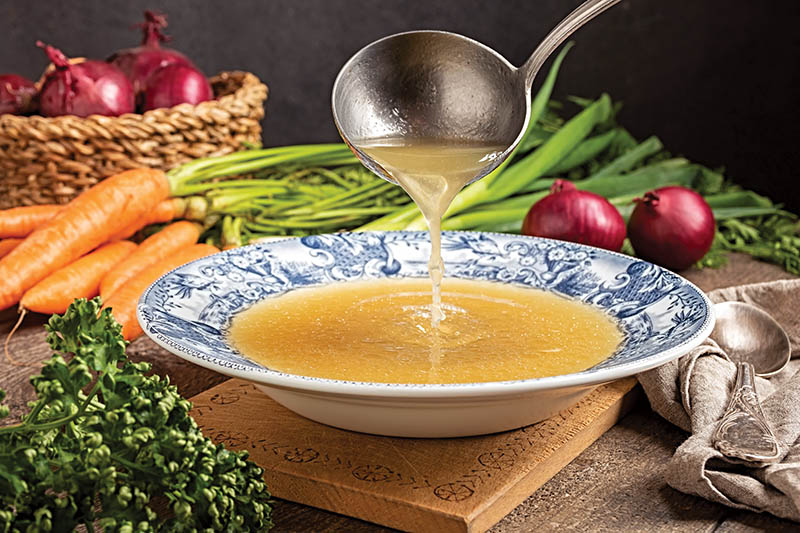A Trend in Nutrient-Dense Animal-Based Foods
Few trends have gained as much traction in recent years as the return to nutrient-dense animal-based foods. Once staples in many traditional diets, bone broth, organ meats, and the nose-to-tail philosophy are making a strong comeback in kitchens across the country. With a focus on sustainability, flavor, and nourishment, these foods are now at the forefront of a new wave of eating that emphasizes whole-body health.
Bone Broth:The Healing Power in a Bowl
Bone broth, a deeply nourishing liquid made by simmering bones, cartilage, and connective tissue, has long been lauded for its therapeutic properties. In recent years, it has become a go-to superfood, popular for its ability to support joint health, boost the immune system, and promote glowing skin. The slow-cooking process extracts collagen, gelatin, and minerals from the bones, offering a rich source of glycine, proline, and amino acids—compounds essential for healthy bones, skin, and tissue repair.
As more people seek alternatives to processed foods, bone broth’s return is driven by its whole-food appeal. Unlike synthetic supplements, bone broth offers a natural, bioavailable way to replenish the body’s nutrients, making it especially appealing to those seeking to improve digestion, support detoxification, and bolster immunity.
For many, bone broth is a nostalgic reminder of home-cooked meals, passed down through generations.
But for the modern cook, it’s a versatile addition to everything from soups and stews to smoothies and sauces. The trend is clear: bone broth is no longer just a health trend; it’s becoming a pantry staple.
Organ Meats: A Forgotten Superfood
Once relegated to offbeat menus or considered “acquired tastes,” organ meats are now seeing a resurgence in popularity. High in iron, zinc, and B vitamins, organ meats such as liver, heart, and kidneys are some of the most nutrient-dense foods you can consume. These cuts pack a punch when it comes to vitamins and minerals, often far surpassing the nutritional profile of more commonly consumed muscle meats.
For centuries, organ meats were considered vital to human health. In fact, many early cultures prized organ meats over muscle meat for their superior nutrient content. Yet, as consumer preferences shifted toward leaner cuts, organ meats slowly fell out of favor. Now, with growing awareness around food waste, sustainability, and health, more people are embracing these cuts as part of a nose-to-tail approach to eating.
Nose-to-tail eating encourages utilizing every part of the animal—ensuring that nothing goes to waste while maximizing the nutritional benefits of all parts. By consuming organ meats, individuals can tap into a wealth of nutrients that are often absent from a typical diet, from vitamin A in liver to coenzyme Q10 in heart.
For those hesitant to dive straight into organ meats, many chefs are creatively incorporating them into dishes where their flavor is subtle yet nutrient-dense. Whether in sausages, pâté, or even ground into burgers, organ meats are finding new life in modern recipes.
The Nose-to-Tail Approach: Redefining Sustainable Eating
The nose-to-tail philosophy is more than just a culinary trend—it’s a movement toward sustainable eating that prioritizes minimizing food waste while maximizing the nutritional benefits of every part of the animal. This approach not only makes use of the full animal but also provides a more cost-effective way to eat healthfully.
As awareness of the environmental impact of industrial meat production grows, many consumers are seeking ways to make their diets more sustainable. Eating nose-to-tail helps to reduce waste, supports local farmers, and ensures that every part of the animal is used in ways that respect its full nutritional value. This sustainable approach is particularly relevant in a time when mindful consumption is at the forefront of many food conversations.
By embracing nose-to-tail eating, individuals are helping to bring back a traditional approach to food that honors both the animal and the earth. In doing so, they’re rediscovering the way our ancestors once ate: with reverence, balance, and a deep connection to the food on their plates.
As the trend toward nutrient-dense, whole-animal foods continues to rise, it’s clear that bone broth, organ meats, and nose-to-tail eating are here to stay. Whether you’re looking to boost your immune system, improve digestion, or simply eat more sustainably, these traditional foods are making their way back into modern diets with good reason. By embracing the full potential of every part of the animal, we can nourish our bodies, reduce food waste, and reconnect with the ancestral roots of our culinary practices.

Pouring chicken bone broth from a ladle into a vintage plate, with fresh vegetables in the background
Homemade Chicken Bone Broth
Ingredients:
Leftover chicken bones (from a rotisserie chicken, roasted chicken, or chicken carcass)
1 onion, quartered (no need to peel)
2 carrots, roughly chopped
2 celery stalks, roughly chopped
3 cloves garlic, smashed
2-3 sprigs fresh thyme
(or 1 teaspoon dried thyme)
2-3 bay leaves
1 tablespoon apple cider vinegar
(helps extract minerals from the bones)
10 cups cold water
Salt and pepper, to taste
Directions:
1. Place your leftover chicken bones in a large stockpot or slow cooker. If you have any leftover skin, cartilage, or wings, add them as well—everything is good for the broth!
2. Add the onion, carrots, celery, garlic, thyme, and bay leaves to the pot. (Editor’s Note: I often will store vegetable scraps—think carrot peels, onion ends, celery leaves—in a bag in the freezer and toss them into my bone broth. It’s a great way to use up scraps!)
3. Pour in the cold water, ensuring that the bones and vegetables are covered. Add the apple cider vinegar and let it sit for about 30 minutes before heating. This helps draw out the minerals from the bones.
4. If using a stockpot, bring the mixture to a boil over high heat. Once boiling, reduce the heat to low and simmer, uncovered, for 4-6 hours. For a slow cooker, cook on low for 8-12 hours. During the simmering process, skim off any foam or impurities that rise to the surface.
5. After simmering, strain the broth through a fine mesh strainer or cheesecloth into a large bowl or another pot. Discard the solids (or compost them if desired).
6. Taste the broth and add salt and pepper as needed. Let it cool, then transfer it to jars or containers for storage. The broth can be stored in the refrigerator for up to 5 days or frozen for up to 3 months.
This homemade bone broth is perfect for sipping on its own, adding to soups, or using in cooking for added depth of flavor. It’s a cost-effective way to make the most out of your leftover chicken, while also providing a nourishing base for your meals. Enjoy!









